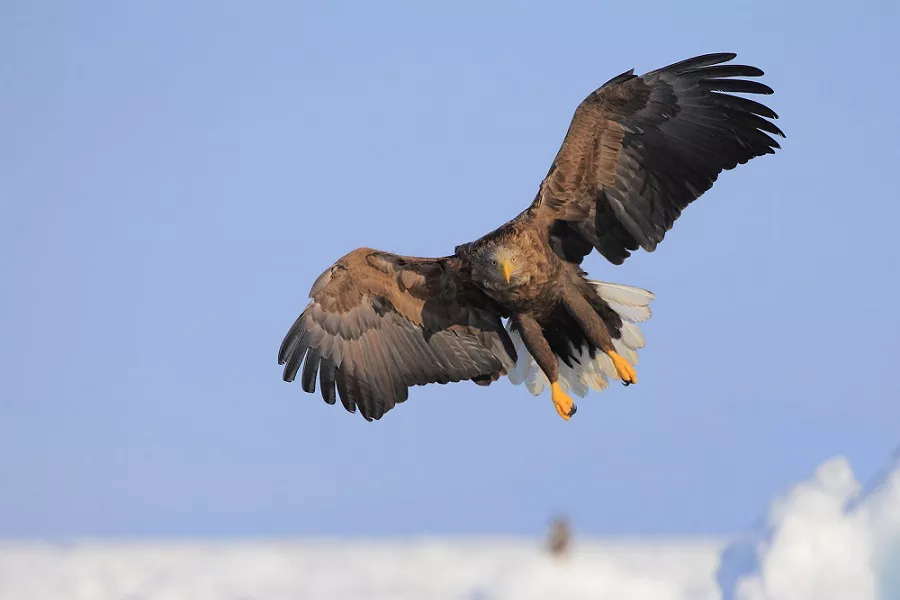The white-tailed eagle (Haliaeetus albicilla), also known as the sea eagle or the Eurasian sea eagle, is a majestic bird of prey that has captivated nature enthusiasts and conservationists alike. With its striking appearance and impressive wingspan, the white-tailed eagle holds a prominent place in the world of avian biodiversity. This article aims to provide an overview of the habitat and range of the white-tailed eagle, shedding light on its distribution and the conservation efforts dedicated to its preservation.
Physical Characteristics
Before diving into their habitat, it’s important to understand what distinguishes the White-tailed Eagle from other birds of prey. They are the fourth largest eagle in the world and can measure up to 3 feet (90 cm) in length with wingspans of over 7 feet (2.1 m). Their feathers are dark brown, with a distinctive white tail and head. The eyes are piercing yellow, making them easy to spot from a distance.
Distribution and Range
The white-tailed eagle is a widely distributed species found in various parts of the Northern Hemisphere. Historically, it inhabited vast areas of Europe, including Scandinavia, the British Isles, and Russia. However, due to extensive persecution and habitat loss, its range was significantly reduced by the mid-20th century. Conservation efforts, including reintroduction programs, have since played a vital role in the recovery of the white-tailed eagle, leading to its expansion into several countries.
Habitat Preference
White-tailed eagles primarily inhabit coastal and wetland environments, with a preference for regions near large bodies of water such as rivers, lakes, and coastal areas. They rely on these habitats for hunting, nesting, and roosting. The presence of adequate food resources, including fish, waterfowl, and carrion, is crucial for the survival and successful breeding of white-tailed eagles.
1. Coastal and Marine Habitats:
Coastal habitats offer ideal foraging grounds for white-tailed eagles, as they enable the bird to take advantage of marine food sources. Rocky cliffs, sandy shores, and estuaries provide ample opportunities for the eagle to hunt fish and seabirds. These areas also serve as suitable nesting sites, typically located on high trees or cliff ledges overlooking the water.
2. Wetland Habitats:
Wetlands, including marshes, swamps, and lakeshores, are essential components of the white-tailed eagle’s habitat. These areas provide diverse prey species, such as waterfowl, small mammals, and amphibians. Wetlands with extensive reed beds or shallow water bodies support the bird’s foraging activities and nesting requirements.
Breeding
Breeding season for White-tailed Eagles varies depending on their location, but it typically occurs in the spring. They mate for life and will often return to the same nesting site year after year. Their nests are large, sturdy structures made from sticks, grass, and other materials. The female will lay one to three eggs, which hatch after approximately 35 days.
Conservation Status and Efforts
The white-tailed eagle faced a severe decline in population throughout the 19th and 20th centuries, primarily due to habitat destruction, illegal shooting, and pesticide contamination. However, dedicated conservation efforts have led to its gradual recovery and range expansion. Strict legal protections, habitat restoration initiatives, and reintroduction programs have played a crucial role in the successful conservation of this magnificent bird.
1. Reintroduction Programs:
Reintroduction projects have been instrumental in restoring white-tailed eagle populations in several countries. By releasing captive-bred eagles into suitable habitats and implementing supplemental feeding programs, conservation organizations have successfully established breeding populations in areas where the species had become locally extinct.
2. International Cooperation:
The conservation of the white-tailed eagle requires international collaboration due to its migratory nature and wide-ranging distribution. Organizations such as the International Union for Conservation of Nature (IUCN), BirdLife International, and national wildlife agencies work together to monitor populations, implement conservation strategies, and exchange scientific knowledge to ensure the long-term survival of the species.
Conclusion:
The white-tailed eagle is an iconic bird with a remarkable distribution across various coastal and wetland habitats in the Northern Hemisphere. Through concerted conservation efforts, this magnificent species has experienced significant recovery and range expansion in recent decades. However, ongoing habitat preservation, sustainable management of food resources, and protection from human disturbances remain essential for the continued success of the white-tailed eagle’s conservation. By valuing and safeguarding its habitats, we can secure a brighter future for this majestic raptor and the ecosystems it inhabits.


 Facebook
Facebook  Instagram
Instagram  Youtube
Youtube 